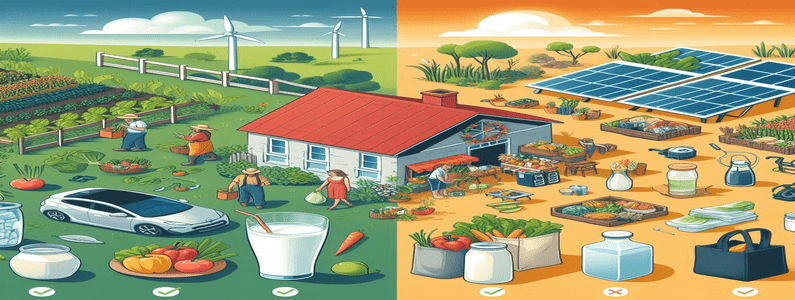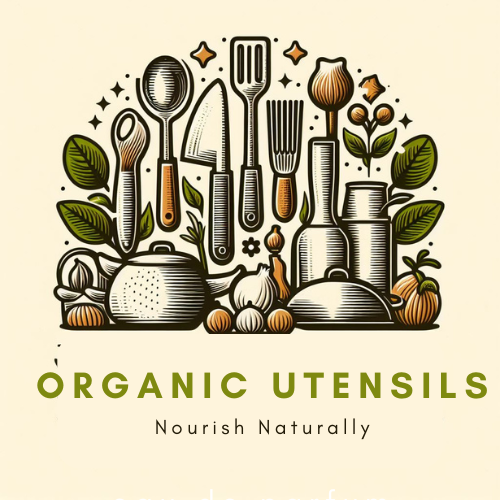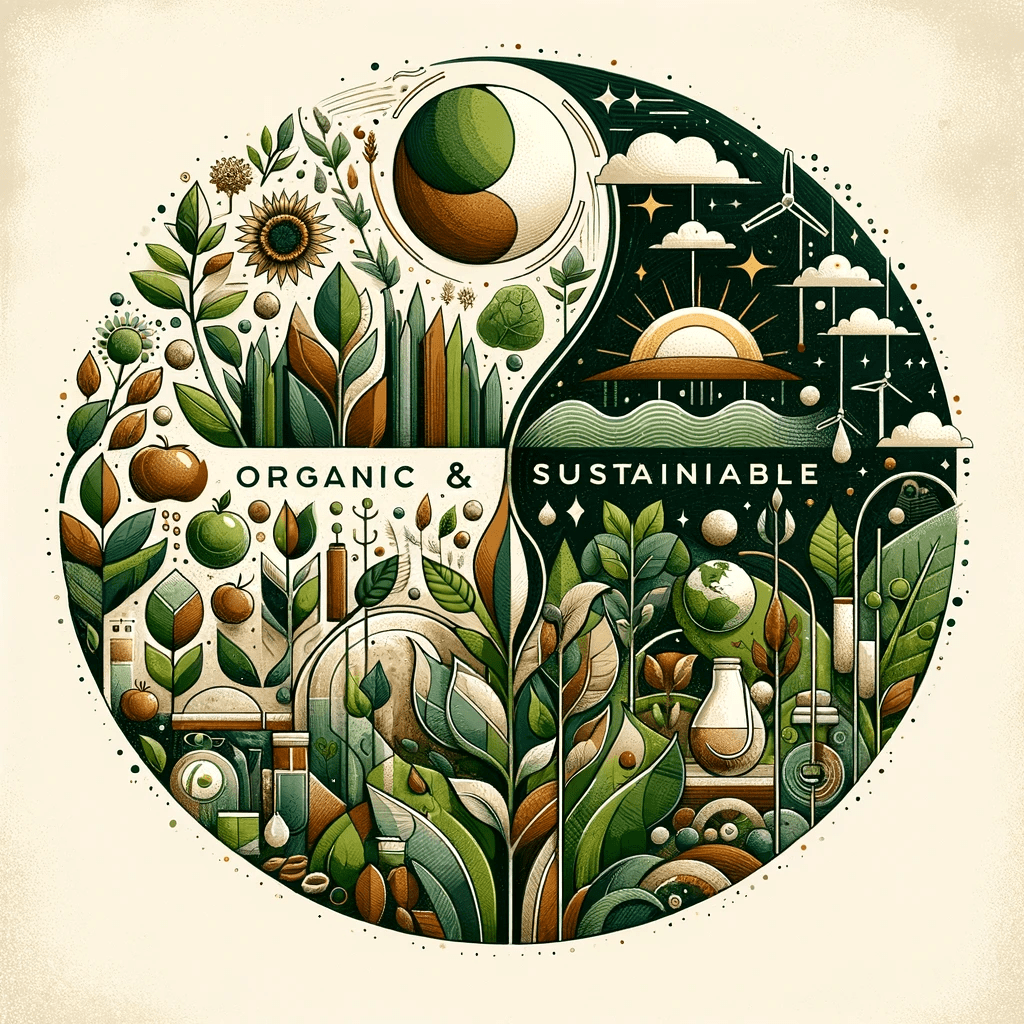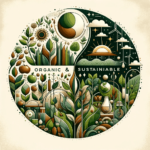The journey toward a healthier planet and healthier selves begins with understanding these distinctions, enabling us to make informed choices that reflect our values and the type of world we wish to inhabit and pass on to future generations.As we get into the differences between organic and sustainable living, we uncover not just the nuances of each approach, but also how they complement each other in fostering a lifestyle that respects our bodies and the Earth.
Sustainable Living
Sustainable living is a broad approach that seeks to reduce an individual’s or society’s use of natural and personal resources. It’s about making choices that ensure our planet’s and its inhabitants’ long-term health and well-being. This includes practices aimed at reducing carbon footprints, conserving water and energy, reducing waste, and making environmentally conscious purchasing decisions.
The Foundations of Sustainable Living
Environmental Protection: Protecting the planet by adopting practices that reduce waste, conserve energy, and minimize pollution.
Health and Wellness: We should choose organic, non-toxic options to promote personal health and the well-being of our communities.
Economic Efficiency: Reducing consumption and waste to save money and resources in the long term.
Social Responsibility: Supporting ethical, sustainable businesses and initiatives that benefit society.
Organic Living
Organic living is a lifestyle choice that emphasizes using organic products and consumables. This means they are produced without synthetic pesticides, fertilizers, genetically modified organisms (GMOs), antibiotics, and growth hormones. The principle extends beyond food to organic personal care items, cleaning products, and clothing. The focus is on minimizing the exposure to toxic chemicals and supporting farming practices that are better for the environment.
The Foundations of Organic Living
Avoidance of Synthetic Chemicals: Choosing foods and products made without synthetic pesticides, fertilizers, GMOs, antibiotics, and growth hormones to reduce health and environmental risks.
Environmental Stewardship: Supporting eco-friendly farming practices that enhance soil health, conserve water, and promote biodiversity.
Health and Wellness: Opting for organic items is believed to offer lower contaminant levels and, often, higher nutritional value for improved health outcomes.
Ethical and Sustainable Practices: Advocating for organic standards that consider animal welfare, worker rights, and minimal environmental impact.
Community and Local Economies: Boost local economies and build community by purchasing locally produced organic goods.
Holistic Approach: Embracing a lifestyle that reflects a commitment to personal well-being, community health, and planetary sustainability.
Differences between organic living and sustainable living
Here’s a detailed table outlining the differences between organic living and sustainable living across various aspects:
| Aspect | Organic Living | Sustainable Living |
| Focus | Reducing exposure to synthetic chemicals and promoting natural processes, especially in food and products. | Conserving resources, reducing carbon footprint, and minimizing environmental impact through lifestyle choices. |
| Key Practices | We choose organic foods, use natural personal and home care products, and support soil health and biodiversity in agriculture. | Using renewable energy, reducing waste, eco-friendly transportation, water conservation, and making sustainable purchasing decisions. |
| Benefits | Reduces chemical exposure, supports animal welfare, and promotes potentially more nutritious food. | Mitigates climate change conserves natural resources, reduces pollution, supports economic sustainability, and promotes a healthier planet. |
| Scope | More focus is on avoiding synthetic chemicals and promoting natural alternatives in products and food. | Broader, encompassing a wide range of practices aimed at reducing environmental impact and conserving resources. |
| End Goals | Promote health and reduce exposure to chemicals, benefiting individuals and the environment. | Ensure the long-term viability and health of the planet, focusing on sustainability. |
Practices of organic living vs Sustainable living
comparative table based on general knowledge about organic and sustainable living practices:

| Aspect | Organic Living Practices | Sustainable Living Practices |
| Food | – Choose foods produced without synthetic pesticides or fertilizers- Prefer foods certified as organic. | Opt for locally sourced and seasonal foods to reduce carbon footprint. Reduce meat consumption to lower environmental impact. |
| Products | – Use personal care and cleaning products made from natural, organic ingredients. Choose organic clothing made without harmful chemicals. | Buy products made from recycled or sustainable materials—support companies with ethical labor practices and eco-friendly production methods. |
| Gardening/Farming | – Utilize organic farming techniques that avoid synthetic inputs. Employ crop rotation, green manures, and composting to maintain soil health. | – Implement water-saving irrigation techniques like drip irrigation. Practice permaculture and other forms of sustainable agriculture. |
| Energy Consumption | – While not exclusive to organic living, using renewable energy sources for farming and production is encouraged. | – Use energy-efficient appliances and lighting. Invest in renewable energy sources, such as solar or wind power. |
| Waste Management | Compost organic waste and minimize the use of plastics and other non-biodegradable materials in packaging. | – Follow the reduce, reuse, recycle philosophy rigorously. Opt for products with minimal packaging. Compost food scraps and yard waste. |
| Transportation | – Similar to sustainable practices, not directly addressed by organic standards. | – Use public transportation, biking, walking, or electric vehicles to reduce carbon emissions. |
| Water Use | – Employ rainwater harvesting and water-efficient irrigation methods in organic agriculture. | – Install water-saving fixtures. Reduce water consumption in daily activities. |
Steps to Living Organically in Sustainable Living
Embarking on an organic lifestyle involves several key steps that can transform your environmental impact while enhancing your quality of life. Here’s how to get started:
1. Organic Diet
Choose Organic and Locally Sourced Foods: Prioritize organic produce to avoid pesticides and chemicals. By buying locally, you can support local farmers and reduce your carbon footprint.
Grow Your Food: If space allows, start a garden. Even small spaces can accommodate herbs and some vegetables, offering fresh, pesticide-free produce at your doorstep.
2. Eco-Friendly Home
Use Natural Cleaning Products: Choose environmentally friendly cleaning products or make your own using natural ingredients like vinegar, lemon, and baking soda.
Energy Efficiency: Reduce energy consumption by using energy-efficient appliances, insulating your home, and utilizing renewable energy sources like solar panels.
Water Conservation: Install low-flow faucets and showerheads, fix leaks, and collect rainwater for gardening to reduce water usage.
3. Sustainable Transportation
Reduce Car Use: To decrease carbon emissions, walk, bike, use public transportation, or carpool whenever possible.
Eco-friendly Vehicles: If a car is necessary, consider an electric or hybrid vehicle to minimize fossil fuel use.
4. Reduce, Reuse, Recycle
Minimize Waste: Adopt a minimalist approach by buying less and choosing items with less packaging.
Reuse and Repurpose: Before throwing things away, consider if they can be reused, donated, or repurposed.
Recycling: Make recycling a habit for items that cannot be reused, ensuring materials like paper, glass, and plastic are correctly processed.
5. Community Engagement
Support Sustainable Businesses: Choose products and services from companies committed to sustainable practices.
Community Involvement: Participate in local environmental groups, workshops, and activities to promote sustainability within your community.
Benefits of Organic Living and Sustainable Living
Here’s a clear table outlining the topic of living organically within the framework of sustainable living, highlighting the individual benefits of each and their combined advantages:
| Aspect | Organic Living Benefits | Sustainable Living Benefits | Combined Benefits |
| Health Benefits | Reduces exposure to pesticides and chemicals, potentially leading to better health outcomes. | Encourages overall well-being through reduced environmental toxins and a lifestyle that supports physical and mental health. | Combining chemical-free living with reduced overall resource consumption enhances personal and environmental health. |
| Environmental Impact | Supports healthier ecosystems through reduced pollution and chemical usage. | It conserves natural resources, reduces carbon footprint, and promotes biodiversity. | Magnifies the positive impact on ecosystems through comprehensive practices that avoid chemicals and minimize ecological footprints. |
| Economic Advantages | This may lead to savings from reduced medical costs due to healthier living. | Saves money in the long term through energy-efficient practices, reduced waste, and sustainable consumption. | Amplifies economic savings and health benefits, supporting both personal finances and local economies with sustainable and organic choices. |
| Social and Community Impact | Promotes ethical food choices and can enhance community connections through local and organic food initiatives. | Strengthens communities through shared sustainable practices, resilience, and local economic support. | Fosters more robust, healthier communities with a shared commitment to ethical, sustainable, and organic practices. |
| Legacy for Future Generations | Ensures the availability of clean, chemical-free food options for future generations. | Leaves a livable planet for future generations through conscientious resource use and environmental protection. | Secures a healthier, more sustainable world for future generations through a holistic approach to living that respects the planet’s limits. |
What to choose between organic living and sustainable living
Choosing between organic and sustainable living isn’t necessarily an either/or decision. Both lifestyles complement each other and contribute significantly to personal health, environmental sustainability, and social well-being. However, understanding the nuances and impacts of each can help individuals tailor their approach to align with their values, circumstances, and goals.
Here’s a focused table on combining the usage of organic living and sustainable living, along with specific examples:
| Combined Approach | Description with Examples |
| Organic Food Choices & Local Sourcing | Opt for organic produce from local farmers’ markets to support local agriculture and reduce emissions from transportation. Example: Joining a community-supported agriculture (CSA) program. |
| Energy-Efficient & Solar-Powered Homes | Invest in energy-efficient appliances and solar panels to reduce reliance on non-renewable energy sources. Example: Retrofitting your home with solar panels and LED lighting. |
| Composting & Recycling | Implement composting for organic waste and establish a robust recycling system for household waste. For example, Start a compost pile for food scraps and use designated recyclable bins. |
| Eco-Friendly Transportation | Use sustainable modes of transportation that reduce carbon emissions, like biking, walking, or electric vehicles. Example: Riding a bicycle to work or using electric car-share services for errands. |
| Sustainable & Organic Product Selection | Choose products that are both organic and produced in an environmentally friendly manner, from clothing to household items. For example, brands committed to fair labor practices and minimal packaging offer clothing made from organic cotton. |
This table illustrates how integrating organic and sustainable living practices into daily life can bring significant environmental benefits, promote health, and support ethical and sustainable economies. Each combined approach offers practical steps and examples for those looking to make positive changes toward a more sustainable lifestyle.
Exceptional Cases Where Organic Practices Might Not Be Entirely Sustainable
There are scenarios where organic practices might not be entirely sustainable, highlighting the complex relationship between organic certification and overall sustainability. While organic farming often promotes environmental health and reduces exposure to pesticides, there are specific instances where it may not align perfectly with broader sustainability goals:
1. Resource Use Efficiency
Organic farming sometimes requires more land to produce the same amount of food as conventional methods due to the prohibition of synthetic fertilizers and pesticides. This could lead to higher land use and, in some cases, contribute to deforestation or converting natural habitats into agricultural land.
2. Water Usage
In certain situations, organic crops may require more water than conventionally grown crops. The reliance on natural pest and weed control methods can sometimes lead to less efficient water use, especially in areas where water scarcity is a concern.
3. Carbon Footprint
The more significant land requirement for organic farming can also produce a higher carbon footprint per food unit. This is due to increased land clearing and the energy consumption of certain organic farming practices.
4. Local vs. Organic Dilemma
Imported organic products can have a larger environmental footprint due to transportation, especially if air freight is involved. In such cases, locally sourced conventional products might have a lower overall environmental impact than organic products from far away.
5. Nitrogen Management
Organic farming relies on natural nitrogen sources (such as manure and compost) instead of synthetic fertilizers. While this can benefit soil health, if not managed carefully, it can lead to nutrient runoff and water pollution, similar to issues faced by conventional agriculture.
6. Economic Sustainability
Organic farming practices are sometimes more labor-intensive and costly, increasing consumer prices. While this can support fair wages and local economies, it may also limit access to organic products for some population segments, raising questions about economic sustainability and equity.
Addressing the Challenges
These challenges underscore the importance of continually improving agricultural practices to ensure they are both organic and sustainable. Solutions include integrating organic practices with other sustainable agricultural methods like agroforestry, permaculture, and precision agriculture to enhance efficiency, minimize environmental impacts, and support biodiversity. The goal is to find a balance that maximizes both the health benefits of organic products and their sustainability, ensuring that organic farming contributes positively to environmental conservation, social equity, and economic viability.
Organic is not “chemical-free.”
The term “organic” refers to how agricultural products are grown and processed. Organic farming adheres to specific standards that vary by country but generally restrict the use of certain pesticides, fertilizers, genetically modified organisms (GMOs), antibiotics, and growth hormones. It significantly reduces the use of synthetic chemicals.
Some chemicals are used in organic farming to manage pests, diseases, and nutrient levels while adhering to organic standards. These substances are chosen based on their natural origin or low environmental impact and are used under strict regulations to ensure they don’t compromise the organic label’s integrity. Their application is typically a last resort, with a preference for physical, mechanical, and biological control methods.
While it might not be accurate to describe organic food as completely “chemical-free,” organic farming practices significantly reduce the reliance on synthetic chemicals. This approach supports environmental health, reduces consumers’ exposure to pesticides and artificial fertilizers, and often results in products with lower residues. Consumers who choose organic foods are generally exposed to fewer synthetic chemicals than conventionally produced foods.
It’s important to note that “chemical-free” is a bit of a misnomer for several reasons:
1. Natural Pesticides and Fertilizers
Organic farming does use pesticides and fertilizers, but these are generally derived from natural sources rather than synthetic ones. Some natural substances used in organic farming can still have environmental or health impacts, although these impacts are typically less severe or persistent than those associated with synthetic chemicals.
2. Environmental Contaminants
Even organic farms can be exposed to chemicals from the surrounding environment, such as air and water pollution. Organic crops can sometimes contain trace amounts of synthetic chemicals, although these levels are usually significantly lower than those in conventionally grown produce.
3. Allowed Synthetic Substances
Some synthetic substances are allowed in organic farming if considered essential and consistent with organic farming principles. The list of allowed synthetic substances is strictly regulated and tends to be much shorter than the list of chemicals permitted in conventional agriculture.
4. Cross-contamination
There’s also the possibility of cross-contamination from nearby conventional farms through the air (pesticide drift) or water runoff, which might introduce synthetic chemicals onto organic fields. However, organic certification processes aim to minimize and manage such risks.
What are the Allowed and Prohibited chemical Substances in organic farming
Allowed Chemical Substances in Organic Farming
| Substance | Type | Usage Notes |
| Copper Sulfate | Fungicide, Algaecide | Limited use for disease control with restrictions on accumulation in the soil. |
| Lime Sulfur | Fungicide, Insecticide | Used for disease and insect control, with application limits. |
| Hydrogen Peroxide | Sanitizer | For sanitizing equipment and disease control strategies. |
| Bacillus thuringiensis | Biological Pesticide | A naturally occurring bacterium is used as a pesticide. |
| Soap-based Herbicides | Herbicide | Non-synthetic, used for weed control in certain non-crop areas. |
| Neem Oil | Pesticide, Miticide | Derived from the neem tree, it is used for pest control. |
| Elemental Sulfur | Fungicide, Miticide | For pest and disease control, careful management is needed to avoid soil accumulation. |
Prohibited Chemical Substances in Organic Farming
| Substance | Type | Reason for Prohibition |
| Synthetic Nitrogen Fertilizers | Fertilizer | It can lead to environmental harm and soil degradation. |
| Synthetic Pesticides | Pesticide | Harmful to the environment and human health; may kill beneficial organisms. |
| Glyphosate | Herbicide | A broad-spectrum systemic herbicide is considered harmful to the environment. |
| Genetically Modified Organisms (GMOs) | Seeds, Crops | Incompatible with organic farming principles. |
| Sewage Sludge | Fertilizer | Potential for contaminating soil with heavy metals and pathogens. |
| Chlorpyrifos | Pesticide | Associated with neurodevelopmental problems and environmental concerns. |
| Synthetic Growth Hormones | Livestock Management | Animals are not permitted to be raised for organic meat or dairy products. |
| Antibiotics | Livestock Management | Use in livestock can contribute to antibiotic-resistant bacteria. |
For detailed information on this, click here.
What are The Challenges Faced by Organic living as well as Sustainable living
| Challenge | Description |
| Higher Costs | Organic products often have higher prices due to more labor-intensive practices and lower yields. |
| Limited Availability | Organic and sustainably produced goods may not be as widely available, limiting access for some consumers. |
| Productivity Concerns | Organic farming is sometimes perceived as less efficient, raising concerns about meeting global food demands. |
| Certification and Standards | Obtaining organic certification is rigorous and costly, potentially deterring small farmers. |
| Reduced Yields | Organic farms may produce lower yields without synthetic fertilizers and pesticides, impacting profitability. |
| Consumer Misconceptions | Misunderstandings about what constitutes organic and sustainable practices can affect consumer trust and demand. |
| Environmental Impact | While generally lower, the environmental impact of organic farming, such as water use, is not always minimal. |
Conclusion
Individually, making choices that align with sustainable and organic principles—such as choosing locally sourced organic foods, reducing waste, conserving water and energy, and supporting sustainable businesses—can have a significant impact when multiplied by millions of people making similar choices. No matter how small, each action contributes to the collective effort needed to address environmental challenges and promote a healthier, more sustainable world.
Sources
National Organic Program (NOP) – Agricultural Marketing Service: This federal regulatory program develops and enforces national standards for organically produced agricultural products in the United States. It also accredits third-party organizations to certify farms and businesses meet these standards, ensuring consumer confidence in the USDA Organic Seal. Find detailed information on organic regulations, certification, and enforcement activities here: National Organic Program.
USDA Organic Portal: This portal provides a comprehensive overview for those already certified organic, considering transitioning, or working with organic producers. It connects you with programs, services, and educational materials to help your organic farm or business. Learn about organic certification, technical training, financial resources, and more at USDA Organic.
Organic Regulations—Agricultural Marketing Service: The NOP has developed detailed regulations and standards for organic production, handling, labeling, and enforcement. These include the National List of Allowed and Prohibited Substances and guidelines for organic labeling. Explore more about the regulatory framework and resources for compliance with Organic Regulations. Find detailed information on organic regulations, certification, and enforcement activities here: National Organic Program.
FAQs on Sustainable Living vs. Organic Living
Q1: Can sustainable living include non-organic products?
A1: Yes, sustainable living can include non-organic products if those products are eco-friendly or contribute to resource conservation. For example, using a reusable water bottle made from recycled materials is a sustainable choice that doesn’t directly relate to organic agriculture.
Q2: Is organic living more expensive than sustainable living?
A2: Organic products often carry a higher price due to more expensive farming practices and certification costs. However, sustainable living can also involve investments like buying energy-efficient appliances or solar panels. The costs vary based on lifestyle choices and long-term investments in sustainability versus immediate organic consumption costs.
Q3: Can living organically guarantee a sustainable lifestyle?
A3: Living organically is a significant step towards sustainability, especially regarding food consumption and reducing exposure to synthetic chemicals. However, a fully sustainable lifestyle also considers energy use, water conservation, waste reduction, and more comprehensive environmental impacts beyond food and product consumption.
Q4: How do sustainable and organic living practices overlap?
A4: Both practices overlap in their aim to reduce environmental harm and promote a healthier lifestyle. For instance, both encourage consuming locally produced food, which reduces transportation emissions (sustainable) and supports organic agriculture (organic). They also share values like reducing waste and supporting ethical and sustainable businesses.
Q5: Are there any challenges unique to organic living compared to sustainable living?
A5: Organic living faces explicit challenges, such as the availability and affordability of organic products, which can be more expensive and less accessible than conventionally produced items. Sustainable living has broader challenges, including making significant lifestyle changes, like reducing reliance on fossil fuels or investing in renewable energy sources.
Q6: What is the impact of organic living on the environment compared to sustainable living?
A6: Organic living reduces the environmental impact by avoiding synthetic pesticides and fertilizers, promoting soil health, and conserving biodiversity. Sustainable living has a broader environmental impact by addressing climate change, resource conservation, and reducing pollution across various lifestyle aspects. Both positively impact the environment, with organic living focusing on agriculture and sustainable living encompassing a more comprehensive range of environmental concerns.




